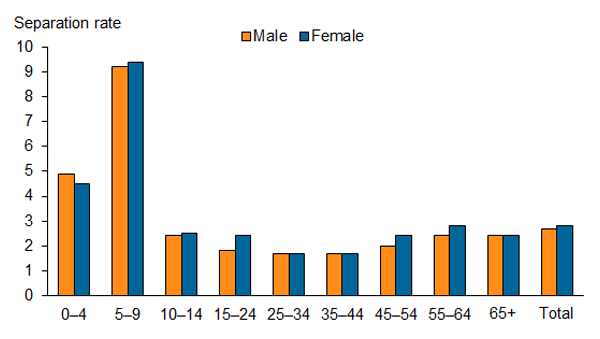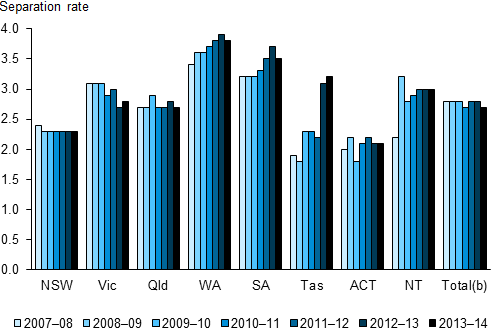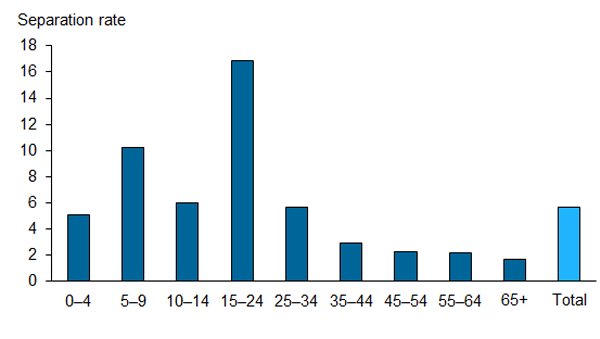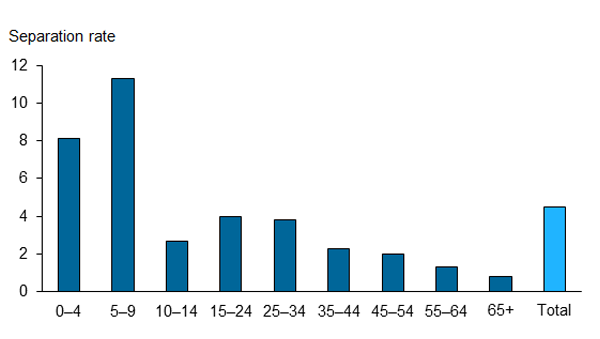Hospital visits
Avoiding hospital
Early intervention can help keep people with oral disease out of hospital. Potentially preventable hospitalisation (PPHs) rates for oral health conditions can be an indication of inadequate access to dental care.
Children aged 5–9 had the highest number of separations related to potentially avoidable dental conditions (13,504 separations or 9.3 per 1,000 children aged 5–9).
The next highest was for children aged 0–4 (7,103 or 4.7 per 1,000 children aged 0–4).
Figure 8: Separation rates for potentially preventable hospitalisations due to dental conditions, by sex and age group, 2013–14

Note: The separation rate (number of separations per 1,000 population) is a crude population rate based on the 2011 ABS estimated resident population. Codes for dental care (below).
Source: AIHW Hospital Morbidity database 2013-14, unpublished.
Between 2007‒08 and 2011‒12 the total number of PPHs due to dental conditions rose from 57,955 to 63,327. This was in line with population growth and the age-standardised separation rate remained steady at 2.8 per 1,000 population. The rate of PPHs was lowest for Major cities (2.7) and highest for Very remote (4.3).

Notes
-
Potentially avoidable hospitalisations related to dental care are defined as the following ICD-10-AM 6th edn (see NCCH 2008) Principal diagnosis categories: K02 Dental caries; K03 Other diseases of hard tissues of teeth; K04 Diseases of pulp and periapical tissues; K05 Gingivitis and periodontal diseases; K06 Other diseases of gingival and edentulous alveolar ridge; K08 Other disorders of teeth and supporting structures; K09.8 Other cysts of oral region, not elsewhere classified; K09.9 Cyst of oral region, unspecified; K12 Stomatitis and related lesions; K13 Other diseases of lip and oral mucosa.
-
Includes Other territories.
-
Excludes records with care type of Newborn (without qualified days), Hospital boarders and Posthumous organ procurement.
-
Number of separations per 1,000 population. Separation rates were directly age standardised, to the Australian population using the estimated resident populations as at 30 June for the respective year.
Source: Australian Hospital Statistics, 2007–08, 2008–09, 2009–10, 2010–11, 2011–12, AIHW Hospital Morbidity database 2012–13, 2013–14
Procedures involving general anaesthetics
In 2011–12, the total number of hospital separations for dental procedures requiring a general anaesthetic was 128,712, or 5.7 separations per 1,000 population.
- People 15–24 had the highest number of separations (51,364, or 16.3 per 1,000 persons)
- Those 65 and over had the lowest (5,288, or 1.7 per 1,000 persons).
Figure 9: Rate of hospital separations for procedure related to dental conditions requiring general anaesthesia, by age group, 2013-14

Note: The separation rate (number of separations per 1,000 population) is a crude population rate based on the 2011 ABS estimated resident population. Codes for dental care (below).
Source: AIHW Hospital Morbidity database 2011–12, unpublished.
For the Aboriginal and Torres Strait Islander population, the total number of hospital separations for dental procedures requiring a general anaesthetic was 3,157 in 2012–13, or 4.5 per 1,000 Aboriginal and Torres Strait Islander population.
Children aged 5–9 had the highest number of separations (923, or 11.3 per 1,000 children aged 5–9), followed by those aged 0–4 (679, or 8.1 per 1,000 children aged 0–4).
Adults aged 65 and over had the lowest number of separations for dental procedures requiring a general anaesthetic (20 or 0.8 per 1,000 Aboriginal and Torres Strait Islander persons aged 65 and over).
Figure 10: Rate of hospital separations for procedures related to dental conditions requiring general anaesthesia, by age group, Aboriginal and Torres Strait Islander people, 2013–14

Notes
-
The separation rate (number of separations per 1,000 population) is a crude population rate based on the 2011 projected Aboriginal and Torres Strait Islander population.
-
In 2011–12, it was estimated that 88% of Indigenous patients were correctly identified in Australian public hospitals. The overall quality of the data provided for Indigenous status in 2012–13 is considered to be in need of some improvement and varied between states and territories.
Source: AIHW Hospital Morbidity database 2011–12, unpublished; Australian Bureau of Statistics, Projected Aboriginal and Torres Strait Islander population, series B, June 2011. Codes for dental care (below)
Codes for dental care
- Potentially avoidable hospitalisations related to dental care are defined as the following ICD-10-AM 6th edition Principal diagnosis categories (for 2013–14 ICD-10-AM 8th edition:
- K02 Dental caries
- K03 Other diseases of hard tissues of teeth
- K04 Diseases of pulp and periapical tissues
- K05 Gingivitis and periodontal diseases
- K06 Other diseases of gingival and edentulous alveolar ridge
- K08 Other disorders of teeth and supporting structures
- K09.8 Other cysts of oral region, not elsewhere classified
- K09.9 Cyst of oral region, unspecified
- K12 Stomatitis and related lesions
- K13 Other diseases of lip and oral mucosa.
Excludes records with care type of Newborn (without qualified days) and records for Hospital boarders and Posthumous organ procurement.
Hospital separations requiring general anaesthesia for dental conditions as defined by following Australian Classification of Health interventions (ACHI) 6th edition block numbers and procedure codes:
- 457 Nonsurgical removal of tooth
- 458 Surgical removal of tooth
- 462 Pulp treatment
- 463 Periradicular surgery
- 465 Metallic restoration
- 466 Tooth-coloured restoration
- 468 Inlay, onlay, indirect
- 469 Other restorative dental service
- 470 Crown
- 471 Bridge
- 472 Other dental service on crown and bridge
- 1909 Conduction anaesthesia
- 1910 Cerebral anaesthesia
- 97241−00 Tooth root resection, per root
- 97387−00 Replantation and splinting of tooth
- 97388−00 Transplantation of tooth or tooth bud
- 97445–00 Exploration or negotiation of calcified root canal, per canal
- 97457–00 Obturation of resorption defect or perforation
- 97458–00 Interim therapeutic root filling
- 97772−00 Provision of resin splint, indirect
- 97773−00 Provision of metal splint, indirect
- 97778–00 Metallic inlay for denture tooth.
Excludes records with care type of Newborn (without qualified days) and records for Hospital boarders and Posthumous organ procurement.


